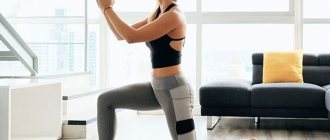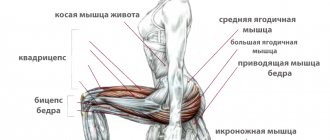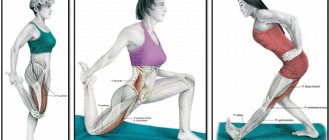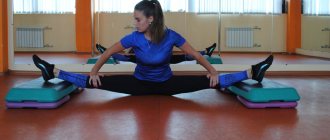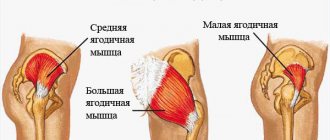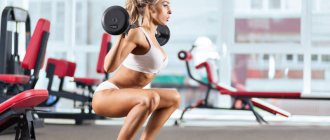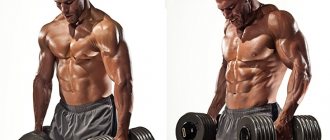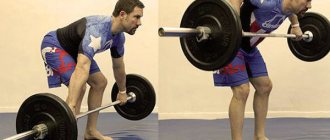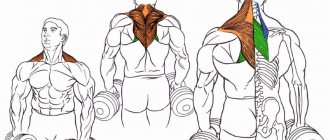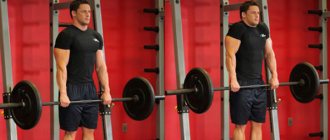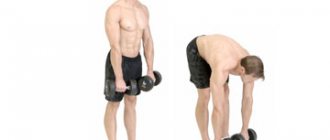Back lunges are a classic leg exercise. They are used in bodybuilding for the development of quadriceps, hamstrings and buttocks, as well as in other sports. Powerlifters and weightlifters do lunges to improve strength in the main movement. Runners - in order to run the distance more consistently and not suffer from distortions in the hips and ankles. In regular fitness, this movement is used as a general developmental one. For many, this may be the main leg exercise on the plan.
Execution technique
Initial position
- The movement can be performed with a barbell or dumbbells. It is necessary to take the projectile from the racks and fix it;
- Then the stomach is tightened, the shoulder blades are stabilized, and the natural deflection in the spine is maintained;
- A step is taken backwards, with the front leg in a position in which the shin is perpendicular to the floor and the toe of the foot is pointed slightly to the side;
Movement
- After taking a step back, bend the knee and hip joints so that you lower your knee to the floor, but do not hit it on the floor;
- The thigh of the front leg is parallel to the floor;
- The hip joint of the working leg falls below the knee;
- When you reach this point, you should tense the muscles of your thighs and buttocks and stand up;
- Next, you need to put your foot down and repeat the entire sequence of movements, first with one leg, then with the other.
Biomechanical analysis of the exercise “back lunges”
Errors
- Feet standing together, or heel to heel with toes pointed out, prevent the athlete from maintaining stability in this exercise;
- A bent back does not allow the legs to be fully loaded;
- The legs are relaxed and “dangle” at the hip joints;
- The athlete takes a step that is too wide and is unable to maintain balance;
- The stepping leg falls outward or inward;
- The position is not stable due to the body being lowered onto the thigh;
- The step is taken too short, and therefore the thigh takes on an acute angle;
- The leg that steps back remains straight;
- When lifting, the supporting leg seems to push the body out of the lunge;
- The movement is not smooth along the trajectory, there are “dips” and “shocks”;
- At the top point of the amplitude, the athlete “pushes” and inserts the knee as if on a deadlift;
- The width of the step changes from repetition to repetition.
High load level
Option No. 1: with a platform
Perform lunges while standing on a platform, lowering your feet to the floor diagonally. The platform will increase stretching of the gluteal muscles.
Option #2: Cross Lunges with Dumbbells
- Take light dumbbells in your hands.
- Lower them straight along the body.
- Perform cross lunges without bending your elbows, holding dumbbells in one position along your thighs.
Option No. 3: with a barbell
- Place a small barbell or empty bar on the top of the trapezius muscle.
- Keep your back straight without bending forward.
- Stabilize your position and tighten your back and abdominal muscles.
- Perform lunges on one leg, then change to the other.
- After this, lift the barbell above your head, lower it slowly to your chest, and straightening your elbows, lower it to the floor.
Important! When working with heavy weights, perform the exercise in a special power rack, removing the barbell from the racks and returning it back immediately after completing the exercise.
Option #4: Smith machine
- Level the bar in the machine by placing it at shoulder level.
- Place the bar on the trapeze, grasp it with your hands wider than shoulder-width apart.
- Lift the bar from the racks, turning the hands, remove the locks.
- Standing in the center, perform lunges on one side, then on the other. Do not rotate your body and pelvis.
- After completing the approach, rotate and secure the bar to the racks.
Recommendations
- Stabilize your core before you begin the exercise;
- Lunges should be performed in the same plane, so there is no need to change the position of the feet during the exercise;
- The feet should be under the pelvic bones;
- The knee of the leg that is stepping back can approach the floor, but should not press into the floor, much less touch it;
- The body is held extremely perpendicular to the floor. Sometimes it is advised to lunge backwards with the body tilted forward;
- Small steps overload the cruciate ligaments of the knee, so it is worth performing steps with a larger amplitude;
- Before extending the hip of the supporting leg, you should focus on the heel;
- The toes of the feet turn inward if the trajectory of the knee joint is constantly changing and the person cannot maintain the optimal working position;
- If a person “inserts” his knee at the top, he seems to take the load off the working muscle group
What changes with step variation?
By changing the step width, it is possible to shift the load on one or another muscle group:
Wide step. With it, the angle of the supporting leg at the knee will be more than 90 degrees
Thanks to this, it is possible to work out and stretch the gluteal muscle well. This variation is often chosen by the fair sex, since it is important for them to focus on the buttocks. However, it is worth considering that if the step is too wide, it will be difficult to return to the starting position.
Normal step With this step, the angle of the supporting leg will be approximately 90 degrees.
In this case, the load falls on the front of the thigh - the quadriceps. As a rule, this variation is practiced by men or girls who need to proportionally pump up their legs.
It is very important to determine the width of your step and not place your feet too close or too far:
- If you place it too close, the active leg will extend beyond the line of the toe, which can lead to a decrease in the effectiveness and increased risk of injury of the exercise.
- If you choose a step that is too wide, the leg will be almost straight and it will be difficult to return from this position to the starting position. This also increases the risk of injury.
Therefore, it is recommended to carefully monitor the width of your step and follow the recommendations so as not to harm yourself and get the maximum effect from the exercises.
Execution options
- Back lunge with reduced amplitude . This movement loads the front surface to a greater extent, lunges with a reduced amplitude;
- Extended amplitude lunge . Allows you to use your buttocks and hamstrings to a greater extent;
- Forward Lunge – This variation of the exercise, along with the walking lunge, is used in athletics and running to develop stepping skills. However, in fitness it is considered traumatic due to the increased load on the knee joint.
►BACK LUNCHES and FORWARD LUNCHES - which is safer and better? Lunges with dumbbells. Lunge technique.
Training programs
Both men and girls often include lunges with dumbbells in their complexes.
Most popular programs:
| Women's Leg Day. Emphasis on the back of the thigh and glutes | |
| Exercise | Sets x reps |
| Romanian barbell deadlift | 4x12 |
| Lunges with dumbbells with an emphasis on the hamstrings | 4x10 (for each leg) |
| Smith squats with emphasis on the hamstrings and glutes | 4x12 |
| Seated leg curls | 3x15 |
| Standing single leg curls | 3x15 |
| Glute bridge with barbell | 4x12 |
| Women's Leg Day | |
| Exercise | Sets x reps |
| Barbell Squats at Smith | 4x15 |
| Lunges with dumbbells | 4x10 (each leg) |
| Leg press in the simulator | 3x12 |
| Plie squats with dumbbells | 3x12 |
| Glute bridge with barbell | 4x12 |
| Superset of leg extensions and flexions in exercise machines | 3x12+12 |
| Men's Leg Day | |
| Exercise | Sets x reps |
| Squats | 4х12,10,8,6 |
| Romanian deadlift | 4x10 |
| Leg press in the simulator | 3x12 |
| Walking lunges with dumbbells | 3x10 (each leg) |
| Leg extensions in the simulator | 3x15 |
| Leg curls in a lying machine | 3x15 |
Recipes for healthy eating
Chicken fillet shish kebab in a frying pan
- 20.4 g Protein
- 1.7 g Fat
- 2.2 g Carbohydrates
- 104.6 kcal
40-60 min.
- #dietary
- #snack
- #green onions
- #corn oil
- #lemon
- #low calorie
- #dinner
- #olive oil
- #snack
- #radish
- #arugula
- #spices
- #dinner
- #apples
- #Apple vinegar
Other recipes
Analysis of the exercise
What muscles work
This is a complex multi-joint movement. The load falls mainly on the front and back of the thigh and buttocks. The torso muscles work as stabilizers, as do the core muscles. Hands hold dumbbells or a barbell and work statically.
The load is distributed between:
- Biceps femoris;
- Buttocks;
- Calf;
- Press;
- Soleus;
- Iliopsoas;
- Arm muscles as weight stabilizers
Preparing for the exercise
The movement is difficult to coordinate. Before starting the exercise, you need to actively warm up the muscles, and no less actively carry out a special warm-up. It means flexion and extension at the knee and hip joints, dynamic calf stretching (bending against the wall) and several sets of back lunges without weight. Some trainers give their trainees back lunges in Smith as a warm-up so that the person actively fills the muscles with blood.
The exercise should start with light weights, gradually progressing to the working weight. Usually a step of 10 kg is enough.
Beginners can do this movement with small dumbbells or a bar, then warming up on the floor is enough. Those who continue can perform the exercise with heavier weights. Everyone needs to check the flooring to make sure their feet don't slip.
How to do it right
- Bending the knee at an acute angle is not allowed. It is necessary to position the foot so that the shin is perpendicular to the floor and the knee does not bend at an acute angle;
- What matters is how stable the shoulder girdle is. The tilt of the body depends on the stability of the shoulder girdle, so you need to tense your back and move your shoulders away from your ears;
- The step length for each person is determined empirically. You don’t need to step back as far as you can just to get a load on your glutes because that’s what it says on the internet. You should choose the step length for yourself;
- Performing a lunge at half amplitude reduces the effectiveness of this exercise and reduces the load on the buttocks and hips, so you should try to do the movement at full amplitude;
- You should not do the exercise with your knee fully touching the floor, and try at all costs to achieve maximum depth;
- The “back” leg should be slightly bent at the knee;
- The movement is performed smoothly, and it should be one. You should not break the exercise into two, and first lower yourself parallel to the thigh with the floor, and then additionally lower your knee;
- Rising from a lunge is performed with effort, resting on the heel.
Lesson: Back Lunges / Exercise Technique
Errors
- Tilt of the body forward and backward;
- Amplitude too small;
- Artificial reduction in step length;
- Bringing the knee behind the toe line;
- Shifting the center of gravity from heel to toe;
- Narrow feet in the starting position;
- Parallel feet;
- Toe push off the floor
Benefits of Lunges in Movement and Target Muscles
Walking lunges are a compound exercise. This means it targets multiple muscle groups at once, including the quads, hamstrings, glutes, core and calves.
This exercise is an excellent way to strengthen your leg muscles and develop strength. It will also help correct muscle imbalances as you work each leg individually.
To get the most benefit from the exercise, perform it at the beginning of your workout.
Increased efficiency
- The greater the weight of the weight, the more difficult the exercise. It will be easier if you use dumbbells, as it is easier to maintain balance with them. With a barbell, you can do the exercise in a lower repetition mode and with more weight, the choice is yours.
- The full amplitude option will be more effective; if you use a shortened amplitude, you won’t be able to work the muscles as well;
- It can also be made more challenging by using sandbags and other types of functional equipment;
- You can also perform lunges from a high platform, or use a low one to start with;
- The exercise will be more effective if you do the movement alternately and return the leg to the starting position each time;
- You can increase efficiency by wrapping a rubber shock absorber around your hips, a method used in running and related disciplines;
- Lunges will be more effective if the lower leg is held vertically, this is suitable for people who tend to bend their knees too much. This way you can rest your shin on the bench;
- Lunges can also be performed with the “back” foot on a small ball, barefoot, or stand, this will help develop balance;
- If there is no weight, it makes sense to add a little jumping load - plyometrics;
- Improving the functioning of the lower extremities in general will also help you progress in lunges. If there is not enough adductor strength to support the knee, you can do isolation exercises on the adductors;
- Some people should do lunges in sneakers rather than weightlifting shoes to keep their working leg stable. In general, choosing shoes is an individual matter. It's worth trying different options;
- If an athlete is training for running, it makes sense for him to do lunges on dirt, sand, or snow to develop natural movement techniques;
- One of the options is a “falling” lunge back, that is, a lunge from a high stand, in which a person holds the support with his hands and lowers his free leg down, bending the working leg at the knee;
- Beginners can do lunges with TPX loops, holding onto them with their hands for balance.
Reverse lunges from the platform
Back lunges are best performed using a platform. The essence of this method is to place the leg on a hill and squat lower during a lunge, due to which more load is placed on the muscles of the buttocks.
When doing this, you need to lean back a little with your body, directing your body weight to the heel of your front leg. Having reached the bottom point, there is a momentary delay in the position, after which, using the force of the quadriceps of the front leg, you need to return to the original position. The exercise is repeated with the other leg.
Important! You cannot rise from the bottom point to the starting point using a push with the back leg. Only the muscles of the working leg should be used in the upward movement.
With a barbell
This exercise is done similarly to exercises with dumbbells. Static lunges with a barbell perfectly work the gluteal muscles. When taking a step forward, make sure that your knee forms a right angle. By tightening your abdominal and back muscles, you will be able to maintain your balance.
All these exercises can be done 10-12 repetitions on each leg (3-4 sets). But if you have not done such gymnastic exercises, you should not immediately put a lot of stress on the muscles. To relieve muscle tension, you can get a massage or take a contrast shower after training.
Each type of static lunge is effective and is aimed at training the buttocks and legs. If you do the exercise correctly, you will feel the tension in your muscles. In order to achieve the best effect, combine lunges with other exercises. But in addition to physical activity, you need to try to eat right and lead a more active lifestyle, then you will have a beautiful and fit figure.
Variations
In addition to the classic version of the movement, there are many more variations that you can use to diversify your workouts.
- Back lunges from a step. Place your working foot on a step or step platform, and step onto the floor with your supporting foot. This version of the exercise better stretches the gluteal muscles and increases the load.
- Lunges alternately with the right and left legs. A good dynamic option for fat burning.
- Lunges in place. This variation of the exercise is convenient when working with weights. In this case, you do not take steps with your feet, but simply stand in a stepwise position and perform squats. This exercise is also called scissor squats.
For high-quality training of the legs and buttocks, the load on the muscles must be complex and varied. Use various exercise options in your program, exercise regularly, and do not forget about nutrition and rest after training. Let working on your body bring pleasure and good results!
How to do backward lunges: video
The back lunge technique is actually not as difficult as it might seem. Videos of backward lunges will demonstrate the correct technique for performing them and will help you not to make any mistakes. In general, this effective exercise can be your wonderful assistant in achieving the ideal shape and relief of the buttocks and hips. The main thing is to perform it regularly, do everything correctly and adhere to safety precautions. This video will help you on how to do backward lunges.
Technique for performing back lunges on video
What muscles work in the exercise
The curtsey exercise is another variation of lunges. As with regular classic lunges, a large number of muscles work here:
- The main load is performed by the quadriceps
- The curtsy lunge has an accentuated effect on the gluteal
- The calf muscles, back muscles (lumbar) and abs also work, which play the role of torso stabilizers.
A common myth in fitness is that cross lunges help reshape your butt. But this is a deep misconception!
The shape of any muscle is set by nature, that is, from birth, and remains unchanged throughout life.
The buttocks are a muscle group just like any other. You can only change its volume.
You can pump up your glutes and make them bigger, or, on the contrary, dry out, burn fat (and possibly some muscle), ultimately reducing the volume. But the shape and outline will be the same in both cases.
Benefits and contraindications of lunges for the buttocks
Lunges are basic exercises that are performed with free weights and work multiple joints at the same time. The subtleties of technology will allow you to work on several goals:
- increase the volume and improve the shape of the legs;
- or buttocks.
This possibility makes the exercise universal for men and women. You can work either with your own weight or with the help of additional equipment - dumbbells, barbells, Smith machine. The exercise has a rather complex technique , the mastery of which requires that you begin with prepared muscles of the legs and back; good coordination during movements is also required in order to stabilize the correct position of the musculoskeletal system.
The main benefits of lunges
- The exercise forms a beautiful shape of the gluteal muscles.
- Develops all muscles of the quadriceps femoris.
- It helps both gain muscle and reduce volume - for certain purposes, the exercise is performed in different modes with different repetitions.
- Accelerates metabolism, capable of burning fatty tissue throughout the body, due to the high energy expenditure during exercise.
- Suitable for both men and women, variations of the technique can control the growth and size of specific muscle groups.
- The exercise can be performed at home - either without weight or with dumbbells and a barbell.
- Develops coordination and improves balance by developing stabilizer muscles.
- Strengthens the cardio-respiratory system with proper execution and proper breathing.
Contraindications for implementation
- Injuries and inflammations of the knee joint, including the meniscus.
- In case of spinal injuries, as well as hernias and protrusions in any part of it, it is prohibited to perform the exercise with a barbell on the shoulders.
- Phlebeurysm.
